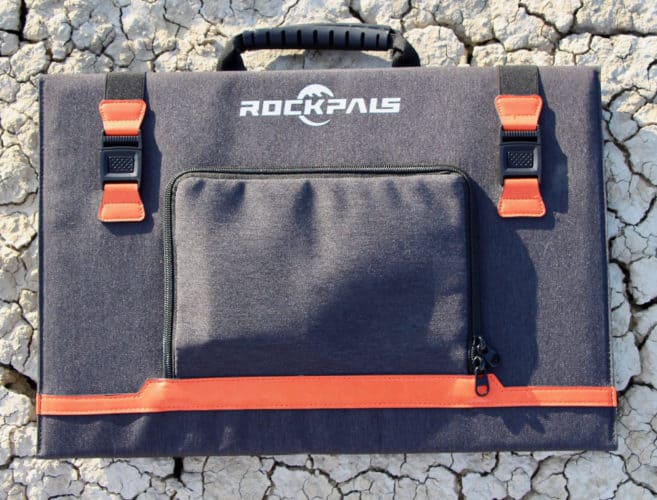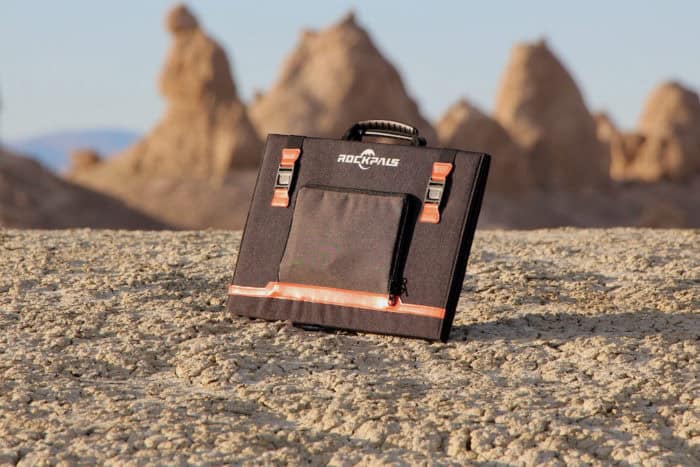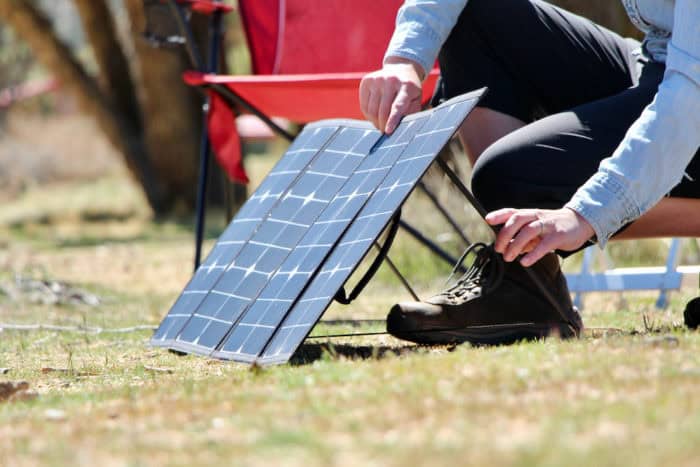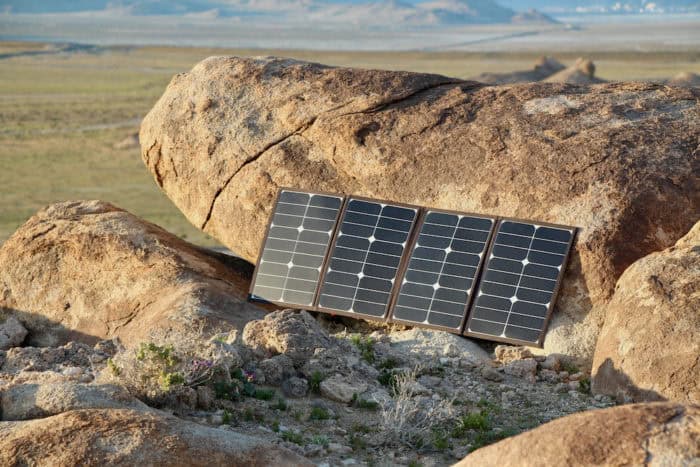Disclaimer: This product was sent to us for free, in exchange for a review. We were not paid by Rockpals to do this review but we did receive it for free. All opinions expressed in this post are based on our personal views and experiences.
Review Of The New Rockpals 80W Foldable Portable Solar Panel
Rockpals is a company that is mostly known for its portable power stations and solar panels.
One of their latest products is the 80W portable foldable solar panel that can not only charge smaller electronics like phones, tablets, speakers, lights, and power banks, but larger batteries like portable power stations as well.
(The 80 watt Rockpals solar panel has now been updated to a 100 watt panel (click to view on Amazon). Many of the features and qualities of the parts are still the same.)
Rockpals 100W Foldable Solar Panel
In this post, I am going to share my thoughts and opinions after using this solar panel for a couple of weeks to charge phones, tablets, speakers, and power stations.
I’ll also let you know how well it performs in different situations.
Let’s start by taking a look at the features.
Features
The Rockpals 80W solar panel is the kind of panel you take with you when you’re going camping in the wild, away from outlets and USB ports tied to the grid.
It’s a great panel to match with a portable power station like the Rockpals 300W (click to view on Amazon) which will power your smaller electronics like phones, tablets, laptops, CPAP machines, or a TV.
It’s lightweight at 5.3 pounds, and the foldable thin design makes it easy to store in a small vehicle or a tent.
The built-in rubber handles make it easy to carry around.
When folded, it measures 16.5 x 11.5 x 2 inches. That’s a little bit too large to fit in my laptop backpack, but it would fit in a large frame backpack.
Two buckles keep the panel folded and are easy to use due to the elastic strap that goes over the top of the panel.
There is a storage pocket large enough to hold a phone, where you’ll find a junction box with a USB QC 3.0 port, a 5.5×2.5mm DC port, and a 5.5×2.5mm parallel port.
The parallel port is for if you would like to connect two panels together for twice the power output.
The USB port is rated at 5V/9V, 2.4A max, and the DC output is rated at 18V, 4.4A max.
Inside of the storage pocket, there is a 5.5×2.5mm to 5.5×2.1mm cable, a parallel cable, an 8mm DC connector, a DC aviation connector, and a DC 3.5×1.35mm connector.
These connectors let you connect the panel directly to portable power stations not only from Rockpals, like the 300W and 500W (click to view on Amazon), but similar products from Goal Zero, Jackery, Suaoki, and nrgGo.
Each cable is 3 feet long.
Related Post: Best Portable Power Stations For Camping
A feature that most foldable solar panels similar to the Rockpals 80W often are missing is a built-in stand.
Rockpals has put a stand on this solar panel that makes it easy to angle the panel to make it face the sun directly which will increase the charging efficiency.
The legs are easy to set up and snaps into place when stored away.
Due to the design and length of the legs, you can also angle the panel more or less, although that will make it less stable in the wind.
It’s a water-resistant panel with an IPX3 rating, but since the junction box isn’t waterproof it shouldn’t be left out on the rain.
The solar panel can be used in temperatures between 14-104F (-10 to 65°C).
My Review
What I Like
My favorite thing about the Rockpals 80W is the portability to efficiency ratio.
It’s a very lightweight panel for how much it can output.
In my tests, as you’ll see later on, it performs almost as well as a 100W rigid panel at 1/3 the weight.
Even though it doesn’t fit in my backpack, it folds and becomes very easy to carry and store.
Another thing I like is charging versatility. It comes with a lot of different DC connectors, in addition to its USB port, so you can charge power stations from a lot of different brands.
I own a Goal Zero Yeti 1000X (click to view on Amazon) and a Jackery Explorer 500 (click to view on Amazon) power station and have been using the Rockpals panel to charge both of them.
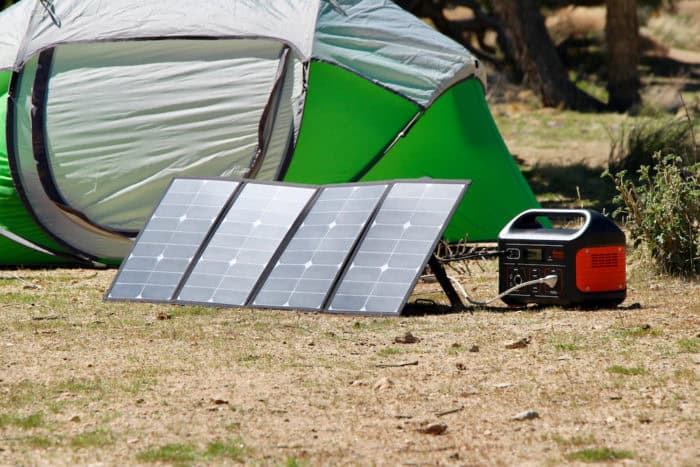
You can use both the DC and USB port simultaneously, so I charged my phone and the Jackery power station at the same time.
I’m impressed by Rockpals for putting a parallel port on this panel that lets you connect two 80W panels together for twice the power.
That’s a feature I haven’t seen on any other portable and foldable solar panel like this.
I also like the built-in stand.
It’s not sturdy enough to where you should leave it out during windy days, but the fact that it has a stand is a huge pro that I wish more companies would put on the portable panels.
Unless it’s around noon in the middle of the summer, the sun won’t be right above you, so being able to angle the panel is a big selling point.
The DC port is actually capable of outputting 79.2W, which is very close to the rated 80W.
And as you’ll see in my tests below, I reached 72W at most with my Goal Zero Yeti 1000 with an MPPT charge controller.
Since the USB port is a 3.0 QC port that can quickly charge supported devices, the USB port is very useful as well.
A detail that might matter to some is the design, and Rockpals has done a great job at making an attractive solar panel that looks modern and not like a gadget from the 80s.
The dark gray fabric with the faux leather below the storage pouch and around the buckles match well with the black monocrystalline solar panels.
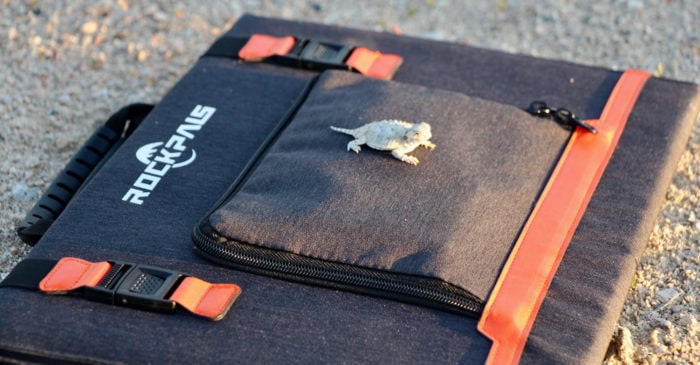
Last but not least, I like that the pocket on the front is large enough to fit all the different charging cables you want to bring.
What I Don’t Like
Something that is missing from the Rockpals 80W panel is an easy way to hang it up.
There are no holes in any of the corners, and the handles are mounted in a way that you can’t hang it from a tree without having one of the panels fold down on top of another panel.
I don’t understand why there are no holes since other Rockpals solar panels have holes for this reason.
One way, in addition to a hole in every corner, would be to have a strong magnet on the back so you could stick it to a magnetic surface.
Another thing I would like to see in an update of this panel is more ports, and it needs to have a USB C port.
The DC and USB ports on there are powerful, but why not have at least two USB ports?
The inside of the storage pouch has an aluminum layer, which I assume is there to protect the electronics from the sun’s UV rays.
The problem is that it’s right behind the panel with not much in-between, so it heats up and gets very warm if you keep it closed up.
Therefore I recommend leaving it open when you’re using the panel.
It would be great if the junction box was waterproof, or at least had anti-dust cover caps on the ports to protect them while not in use.
The cables pick up dirt, which ends up in the storage pouch, and eventually in the ports.
Durability
It’s worth noting that I have only been using this panel daily for almost a month, so while I can tell you how it’s holding up so far, I’ll need to update the review in a couple of months.
I’m impressed by the stitching and finish of the panel, it’s very well-built.
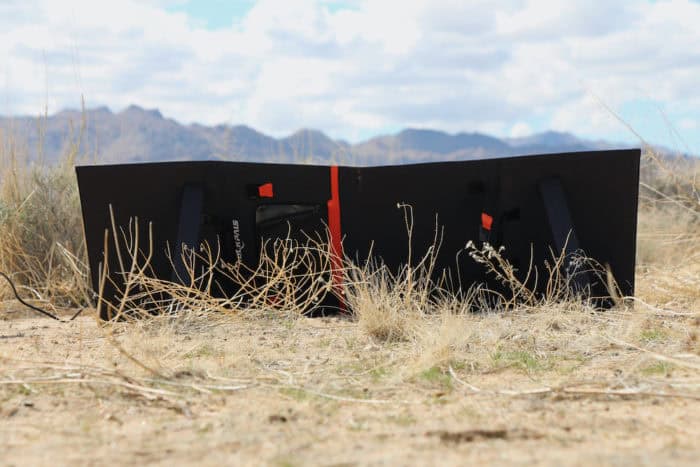
The panel has an IPX3 rating, but the junction box isn’t waterproof in any way, so I wouldn’t leave it out in the rain.
Fabric gets dirty, but it appears that the material used by Rockpals is a good quality fabric that is easy to wipe dirt off of.
The panels scratch easily since they’re the soft and flexible kind, so if you’re using the panel in wind you should put some rocks down on the legs to prevent the panel from blowing over.
Portability
It’s a relatively portable solar panel at 5.3 pounds, but it’s not small enough to fit in my laptop backpack.
I wouldn’t bring this panel backpack hiking, but that’s not what this panel is for.
The way it folds up makes it easy to store in an RV, car, or tent. And the buckles are reliable and won’t open up even if you swing the panel around.
Usability
This kind of solar panel that folds and weighs less than 6 pounds is more usable for camping for some than the rigid solar panels due to how little space they take up in storage, and how quickly you can set it up/fold it.
The downside is the sturdiness of the legs when it gets windy and the fact that it shouldn’t be left out in the rain.
I recommend putting rocks on the legs every time you use the panel to prevent it from falling over if a wind gust hits it.
It has worked for me to keep the panel standing even in 15-20 mph winds.
Once you get the hang of opening the buckles and setting up the feet, the panel is easy to set up in about 10 seconds.
One tip I have is to connect the cable you’re going to use to the junction box before you set the panel up because it’s easier to do than when the legs are down.
With the DC and USB port, you can charge a lot of different devices.
I don’t have a USB QC 3.0 device, so I couldn’t test the quick charge capabilities, but I could charge my iPhone quickly.
Here is how the ports performed with my devices:
DC port to Goal Zero Yeti MPPT – 60-72W
DC port to Goal Zero Yeti PWM – 55-65W
DC port to Jackery Explorer 500 – 56-65W
USB port to iPhone 11 – 12.25W
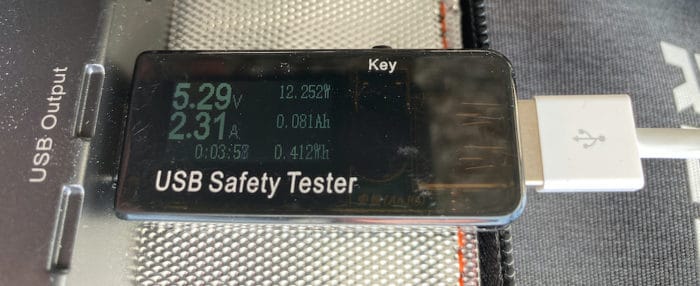
I also used the solar panel when it was cloudy outside and the USB port was putting out the same amount of power, but the Jackery lost about 60% of the wattage and the Goal Zero about 40% when using the MPPT charge controller.
Since it’s an 80W panel, it will be able to output at least 5-15W through the USB port most of the time which is great.
To make it even better, Rockpals could’ve added more USB ports or a USB C port.
Conclusion
I like the Rockpals 80W solar panel, it performs the same if not better than similar panels I have tried, and I was surprised by the power output it was capable of.
I don’t have a lot of complaints, but there are a couple of improvements I can think of.
The first thing is the number of ports.
If you only need to charge one USB device at a time or a power station (which probably has more USB ports anyway) you’re going to be fine.
But since the panel is so powerful, I would’ve rather seen a USB C port than a USB 3.0 QC port or at least two USB ports.
It’s great that there is a built-in stand, but the legs are only sturdy until the wind comes around, so that’s a downside if you’re going camping somewhere windy.
I have been putting rocks on the legs which have made it more usable in the wind, and I recommend doing so even if it’s not windy as a precaution.
A couple of holes could’ve been a way to stake the panel down. It also would’ve been a way to hang up the panel in a tree or on a vehicle.
To conclude, it’s a great solar panel for going camping in the summer if you have a power station like the Rockpals.
But the features that are missing make it a less optimal choice for spring, fall, and winter camping when the weather is less predictable.
Unfortunately, that’s the case with most portable foldable panels like this.
Which is why you might as well go with this one since it has an impressive power output and is compatible with a lot of devices and power stations right out of the box.
We’ll see how it holds up over time, and I will come back and update the review in the future if I run into any issues.
Similar Products
Rockpals sells solar panels that are both smaller and larger.
There is the 60W model (click to view on Amazon) and the 120W model (click to view on Amazon).
Frequently Asked Questions
Can I Charge An RV Battery With The Rockpals 80W?
You can, but since it doesn’t have a charge controller built-in I wouldn’t recommend trying to charge an RV battery with it.
You’d also need DC to alligator clamps/ring terminal cables, these are not included.
Does The Solar Panel Store Power?
No, the solar panel does not store power since it doesn’t have a battery.
You must connect the panel to some kind of battery or the electricity goes to waste.
Is It A Monocrystalline Or Polycrystalline Solar Panel?
It’s a monocrystalline panel with an up to 23% conversion efficiency rate.
How Long Does It Take To Charge A Power Station With It?
Here are some estimates of how long it takes to charge a power station with the Rockpals 80W.
Note that the Rockpals 500W has a larger battery than the Jackery Explorer 500 but charges faster due to the MPPT charge controller.
Rockpals 300W (click to view on Amazon) – 4 hours
Rockpals 500W (click to view on Amazon) – 8 hours
Jackery Explorer 500 – 9 hours
Goal Zero 1000 – 17 hours
Can I Use The Rockpals 80W To Charge A Goal Zero Yeti Or Jackery Power Station?
Yes, the Rockpals panel includes an 8mm DC connector which can be used with both Goal Zero and Jackery power stations that have an 8mm input.
Please leave a comment down below if you have any questions.


